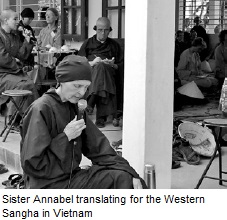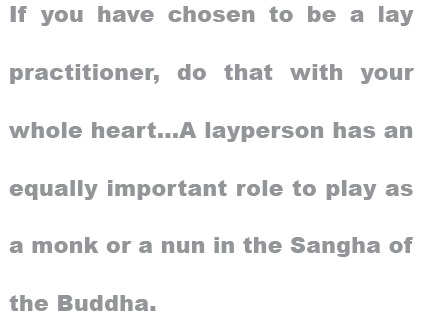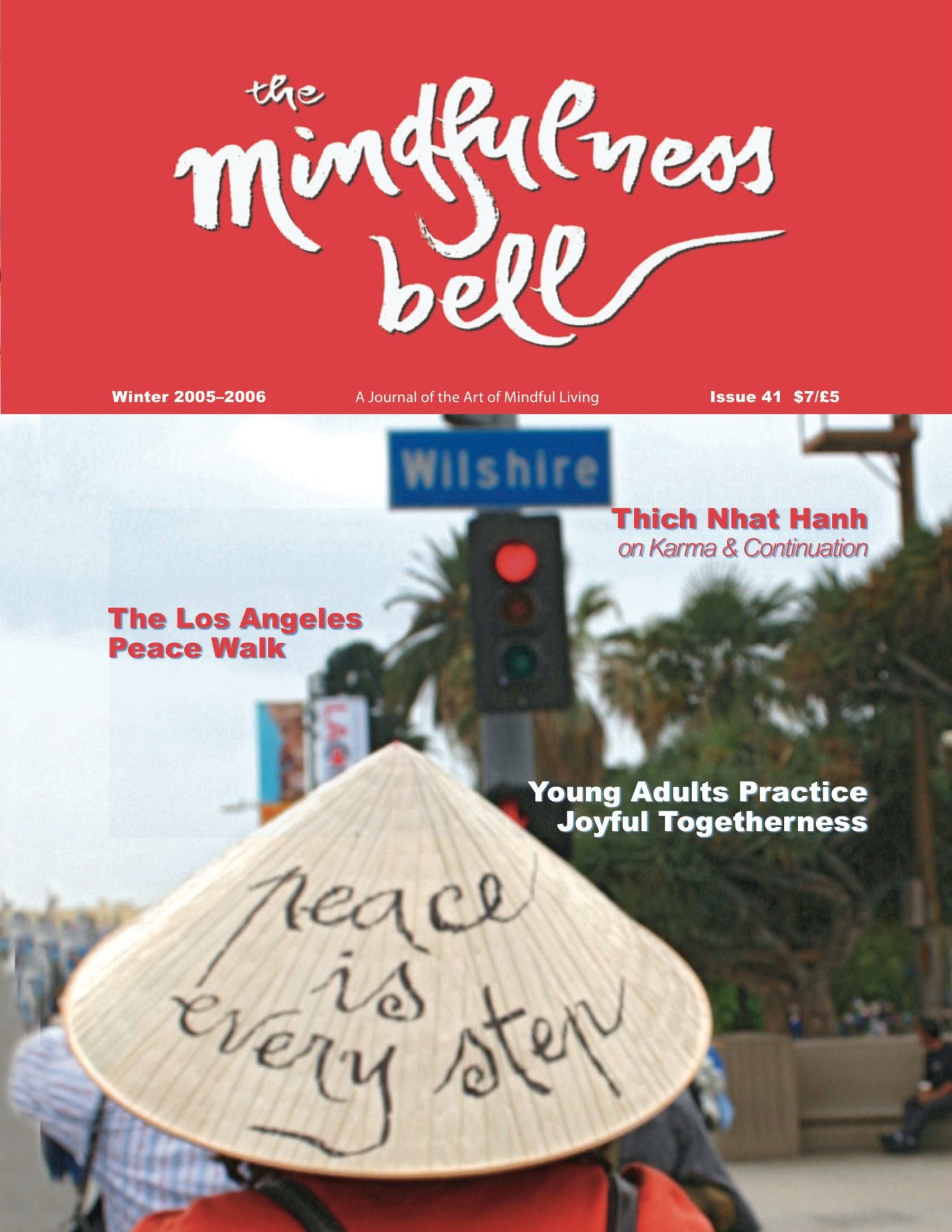in the Time of Buddha Shakyamuni
By Sister Annabel, True Virtue

With the publication of Freedom Wherever We Go (1)the Revised Pratimoksha (precepts of the fully-ordained Buddhist monks and nuns) becomes available to be studied and read by laypeople.
Traditionally, lay practitioners have not been permitted to read the Pratimoksha. The Buddha did not forbid it, since in the time of the Buddha the Pratimoksha was never written down,
in the Time of Buddha Shakyamuni
By Sister Annabel, True Virtue

With the publication of Freedom Wherever We Go (1)the Revised Pratimoksha (precepts of the fully-ordained Buddhist monks and nuns) becomes available to be studied and read by laypeople.
Traditionally, lay practitioners have not been permitted to read the Pratimoksha. The Buddha did not forbid it, since in the time of the Buddha the Pratimoksha was never written down, but he did forbid the recitation of these precepts by the monks in the presence of the laypeople. It is still forbidden. When we recite the Revised Pratimoksha, in the Sanghakarman procedure which precedes the recitation, the question is posed: “Have those who have not yet received the bhikshu ordination already left?”
This is because at several junctures during the recitation the monks and nuns are asked: “Is your precepts’ body pure?” One needs to be in the safety of one’s own Sangha to consider this question; and the same is true for the lay Sangha. If someone were to feel the need to express regret for not having observed the five or the fourteen mindfulness trainings, it would be best for them to confess within the small circle of their local lay Sangha friends who know them well. If we express regret for an offense outside of our small practice family it can lead to many wrong perceptions.
Apart from that, the lay Sangha can and should scrutinize the practice of monks and nuns with regard to precepts and fine manners. This has been the case since the time of the Buddha.
Monastics and Laypeople Influencing One Another
When we read the texts of the Vinaya (2) the allusions to lay practitioners are everywhere. The first reason is that the Vinaya is not just concerned with how monks or nuns relate to one another, but also with how monks and nuns relate to laypeople. The second reason is that many of the disciplinary measures taken by the Buddha and the Sangha arose because laypeople disapproved of a certain behavior they had observed in monks and nuns. Thirdly, many of the concessions to austerity allowed by the Buddha also came at the suggestion of the laypeople.
For instance, one time at Kitagiri, a lay practitioner heard some young men asking a monk if he would act as a go-between for them and a young lady. They had already tried to persuade the young woman to come with them on a picnic but she had refused.
The lay practitioner was shocked when he heard the monk assent to this request. He could not understand how a monk could agree to do such a thing. He reported the matter to senior monks who immediately saw the impropriety of such an action and told the Buddha. The Buddha made a precept forbidding monks and nuns from acting as go-betweens and matchmakers (3).
This incident shows how laypeople can inappropriately support the misbehavior of monks and bring the level of the practice down for everyone, or, more appropriately, seek the advice of monks who are strong in the practice.
Kitagiri was a town far from the important practice centers of the Buddha. Some monks who were weak in the practice had taken up residence there, and far from the supervision of the greater Sangha, they had adopted bad habits. The laypeople who may never have received correct instruction in the practice supported the misbehavior of the monks and even encouraged it, since they also wanted to join in the fun. The misbehavior consisted in taking part in worldly singing and dancing, playing betting games, making flower garlands, sitting with laywomen, and eating off the same plate. Things had gone so far that when a monk who was practicing correctly passed through the town he was laughed at and no one would offer him his midday meal.
However, in Kitagiri there was one lay family who had remained loyal to the true practice. They were delighted to see a monk who was walking serenely through the town on the traditional alms round. They were dismayed to learn that, although it was already late in the morning, the monk had received no alms. They took him to their house and offered him the midday meal. When he had eaten they asked him to report the state of affairs of Buddhist practice in their town to the Buddha. After this the Buddha sent the venerables Shariputra and Mahamaudgalyayana to put things back in order.
Help from Lady Visakha
There are lengthy accounts of well-renowned lay practitioners from the time of the Buddha. Anathapindika is the most outstanding layman and Visakha the most outstanding laywoman. These two figures had had connections with Buddhas in many past lives and had made the aspiration to support a Buddha and his Sangha. Lady Visakha was richly endowed with material means and was always ready to make offerings to the monastic Sangha. Secondly, she made many suggestions about small changes in the daily life of monastics that would mean less hardship for monks and nuns. Thirdly, she had no fear of pointing out the misbehavior of monks and nuns when she saw that it was endangering the reputation of the Buddha and his monastic Sangha. Sometimes she would speak directly to the monk or nun whose behavior she could not countenance. Otherwise she would go directly to the senior monks, nuns, or the Buddha. Her heart was filled with loving kindness for the Buddha and his Sangha, and her actions were always based on this and her deep observation of the situation.
Lady Visakha had a nephew who wished to ordain as a monk. He made his request during the rains retreat and was turned down. The monks told him that they had decided before the retreat that they would not accept any ordinands during that retreat. At the end of the retreat he said that he would not ordain. Lady Visakha was very disappointed and reported to the Buddha what had happened. The Buddha made a precept that monks cannot make blanket decisions that they will not ordain those who request ordination at a particular time.
The Buddha also gave permission for members of the monastic Sangha to leave the monastery for a maximum of seven days during the rains retreat if sent for by a layperson who was making a special offering, like monastery buildings, and if the layperson made the request in person. In other cases of great need by the lay Sangha a monk had permission to leave for seven days. Seven days was not a long time since the monk would travel on foot, so some of that time would be spent traveling. In the Plum Village Sangha of the present time, leaving the three-month retreat for any reason is strongly discouraged. Nowadays laypeople who feel in need of teachings from the monastics have the opportunity to stay at Plum Village or another center belonging to this lineage in North America or Europe.
Once Lady Visakha saw a monk sitting in a secluded place with a laywoman. She went directly to the monk and told him that this was unseemly. When the monk appeared unmoved by her words, she went to the senior monks who reported the matter to the Buddha, who made a precept forbidding such behavior. Not many of us would be as forthright as Lady Visakha. We should probably prefer to go directly to senior monks and report what we had seen.
There is recorded in the Vinaya an incident that shows the compassion and understanding of Lady Visakha. She came to the Buddha and asked if he would grant her eight wishes. The Buddha replied that he was not a teacher to grant wishes, but he would listen to her wishes. Lady Visakha lived near Sravasti and her wishes were for monks and nuns who happened to come to Sravasti.
- She wished to offer robes to the monks and nuns for the monsoon season. She had seen monks going about stripped to the waist because they had no dry robes to wear. They resembled the sect of naked ascetics and she did not think it was appropriate that people could not identify Buddhist monks.
- She wished monks who were newly arrived in Sravasti to be sent to her home for a meal. She had observed that when monks arrived they were tired and hungry and it was too much for them to have to make the alms round.
- She also wished to give monks a meal before they set out on a journey so they didn’t start out hungry and have to make the alms round in a strange place where they were not sure where they were
- She wanted to offer medicine to any monk or nun who was sick. She had been distressed to see sick monks and nuns without the means to acquire
- She wanted to offer food to any monk or nun whose ill health prevented them from going on the alms round.
- She wanted to offer food to any monk who was tending the sick, since it was not good for such monks to have to leave their charges in order to make the alms
- She wanted to provide the monks and nuns with a breakfast of rice porridge every day. She felt that it would improve their health.
- She would offer bathing robes to all the nuns in Sravasti. She had heard that they bathed naked and this was not appropriate.
When she had expressed these eight wishes the Buddha asked her what benefits would accrue to her through their fulfillment. She said that if a monk came to Sravasti and reported that one of them had died, she would ask: “Did the monk who has died ever come to Sravasti?” If the answer was “Yes,” she would conclude that that monk must have received the benefit of at least one of her eight wishes. Such news would bring her happiness and peace of mind. From this would result concentration and other spiritual fruits of the path of practice. The Buddha approved of her answer and granted her wishes.
Laypeople Help in Monastic Dispute
It is clear that the Buddha was ready to listen to suggestions from the laypeople about monastic life. The kings Bimbisara and Prasenajit also made suggestions that were adopted by the Buddha. It was King Bimbisara’s idea that the followers of the Buddha should celebrate an Uposatha day. This later became the day twice a month when the monks and nuns recited their precepts.
The dispute at Kosambi shows how the laypeople helped the Buddha bring to an end a serious dispute that had arisen in the monastery. As soon as the Buddha heard that there was a dispute concerning the infringement of a minor rule, he gathered the monks and gave teachings on the benefits of harmonious living. He met both sides in the dispute and told both that they should concede. However some of the monks had not wanted to listen. One monk had even stood up and asked the Buddha not to interfere. At that point the Buddha left the monastery and went into the forest alone. Later the monks even came to blows. The laypeople were extremely distressed about the dispute and that the Buddha had left. They came together and decided that they would not greet, stand up for, join palms before, or give alms food to the monks. This action convinced the monks that it was time to change their behavior and practice what the Buddha had advised them to practice in the first place.
Turning the Bowl Upside Down
There were times when laypeople acted inappropriately in their relations with the monastic Sangha. One layman participated in a scheme to bring disrepute upon a senior monk. At the instigation of some monks who were very angry with the senior monk, this layman reported falsely to the Buddha that his wife had been sexually assaulted by the senior monk. When it was proved to the Buddha that this was a calumny the Buddha instructed the monks never again to call at that man’s house on the alms round and that no offerings should be received from him. It was called “turning the bowl upside down.” When the man heard about this from Venerable Ananda, he was so shocked that he fainted. Other laypeople came to his aid and suggested his whole family make confession of this transgression. When this was done, the Buddha gave instructions for the monks to “turn the bowl upright again,” to receive alms from this man.
Prostrating to the Sangha
Since the laymen and laywomen constitute half of the Buddhist Fourfold Sangha, they have the right to scrutinize carefully the comportment of monks and nuns. This is not judgment. In Asia laypeople commonly prostrate before monks and nuns. This can be a dangerous practice if the monks and nuns have not been trained to receive prostration and to remain humble. As monks and nuns we should see that when someone prostrates before us they are not reverencing us as an individual. They are paying respect to the Buddha’s Sangha that we represent; they are no more paying respect to us than someone reverences a flag that represents a nation. If I thought that I were receiving the prostration because of who I am as an individual, that would lead to pride and be very dangerous for my practice.
There was a monk in Vietnam who was not practicing the precepts well. A devout laywoman prostrated before him. Her friend admonished her: “Do you not know that that monk is not practicing correctly?” The lady replied that she knew that the monk was not practicing correctly but maybe that prostration would bring the monk to his senses, reminding him that he was still a part of the Buddha’s Sangha in which the laypeople have great faith.
At the end of his life Anathapindika made the request that laypeople, as well as monks and nuns, should receive the deepest teachings of the Buddha on no-birth and no-death. In our time laypeople receive these deep teachings and have an opportunity to put them into practice while working, raising a family, and supporting the monastic Sangha.
One of the aims of monastic discipline is to show ways in which monks and nuns have become burdensome to the lay Sangha and to encourage them not to do things that can cause difficulties for laypeople. Examples are: using money which has been donated for a specific purpose, for another purpose; receiving more than one midday meal at the same house on consecutive days; accepting an invitation to eat at one home and then going to another home to eat first; making demands that laypeople cannot easily fulfill.

Laypeople often ask how they can best support the monastic Sangha. If you have seen your path clearly as a lay practitioner and you are happy and solid in it, that is the best support you can give to the monastic Sangha. It means that you know how both paths of lay and monastic practice are equally valid and mutually supportive. You feel close to the monks and nuns and keep in regular communication so that the monks and nuns know what the real difficulties facing a lay practitioner are and we can work together on developing suitable Dharma doors to help. It is very encouraging when we, as monks and nuns, hear from lay practitioners about how they are using the practice to deal with situations they meet in their family and at work. When we hear about the suffering that you encounter and know about the different misfortunes we may have been sheltered from, it helps motivate us to practice more diligently so that we can liberate ourselves and others.
If lay Sanghas can organize study groups and Dharma discussion concerning the Revised Pratimoksha it will bring us closer together as a fourfold Sangha. Just as monks and nuns want to support the lay practitioners in their practice of the Five and Fourteen Mindfulness Trainings, so the lay practitioners can support the bhikshus and bhikshunis in their practice of the Pratimoksha.
Note: Green Mountain Dharma Center is being developed as a center for the practice of the Fourfold Sangha, where monks, nuns, laymen, and laywomen will live and practice together.
Sister Annabel, True Virtue, is the abbess of Green Mountain Dharma Center in Vermont, and the senior editor of the Mindfulness Bell.
1 Thich Nhat Hahn, Berkeley: Parallax Press, 2005 2 The corpus of literature connected with monastic discipline. 3 “Freedom Wherever We Go,” pp.36 & 92.

